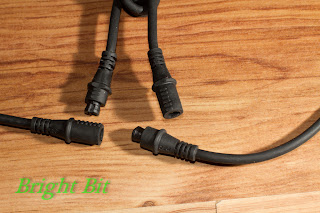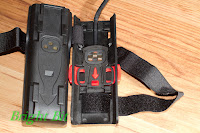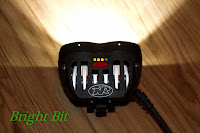
Just before the winter holidays started my latest obsession was finally in my hands, muhaha!! Yes, it's the new NiteRider Pro 1400LED bike headlight. Ever since I've seen it while surfing on Amazon I knew I must have it. Awesome specs, good reviews and huge potential to be the ultimate light source for all my outdoor activities: biking, caving, mountaineering and even photography.
So now that the holidays are over and I had the chance to put it to test in all the above mentioned activities, I can sit down a little and tell you all a little about this amazing product.
Starting with unpacking.. As I already knew from the reviews I read on the net the light came in a pouch with everything packed in really tight. So tight that once you get all the parts out, it's hard to put them back together to fit the pouch.
Together with the light I also got the NiteRider Explorer Headband which is needed for using the light as a headlight in mountaineering or if biking without a helmet. The headband is wide enough to handle the 200 gr weight of the light head and offers 4 plastic hooks to aid cable routing to the battery pack. Wearing it I did get a little bothered by the head pressure caused by the light head support pressing. I guess more padding would have been needed but it's something you get used to.


First thing that stroked me after looking at the light head was the fact that it didn't resemble the picture on NiteRider's website. That's because the picture there is actually of a Pro 1200 light system. The difference between the previous Pro 1200 and the current Pro 1400, besides the actual light output, is the presence of two light pipes, one for each reflector. You can see them in the first picture as two small dots. Their purpose is mainly when using the light on a bike, to show you which reflector is turned on. The actual LEDs inside each reflector are
Cree XLamp MC-E.
Moving on with the close eye inspection, I checked the cables and the connectors. The cable is very thick and rugged and the connectors well build. They are trapezoidal in shape with a flat matching key, they lock securely and offer quite good water proofness. The only problem that i could see is extra caution needed when connectors are unplugged/plugged in dirt/wet filled environments.

The battery pack is the biggest and heaviest part of the system. That's usually overcame by fixing it on the bike frame or caring it in the backpack, keeping it in a pocket is very uncomfortable. Quality is great, rubber pad for fixed mounting on the bike frame with Velcro straps that can easily be removed if you want to gain weight and space in non-bike activities. I wanted a little more info about battery pack maintenance so here are the producers recommendations:
When charging the battery, it should be done inside at room temperature. The batteries should not be charged below or above certain temperatures. There is a safety circuit that will shut off the charge if it is in such temperatures. For long term storage, it is best to store the battery at about 40% charge. If you are storing the battery for longer than a couple of months, it is best to store it at 50% then, about once every six to eight weeks, fully discharge, fully charge then discharge to about 50% for storage again.


The helmet mount will only work with vented helmets. It uses two straps that need 4 frontal vents in the helmet to get a fix. It won't work on most full helmets or a climbing helmet like my Petzl Elios, since the need of the Explorer Headband.
The handlebar mount is pretty straight forward and easy to use. The material is plastic and not metal like I think i read on a website. Just in case you need it, it comes with an extra rubber pad and an Allen key.
The unit also comes in with what one can call a docking station since it's more than just a charger. Besides the power jack and the battery cradle, the unit also has an mini USB port and a connector to plug in the light head. You do this to program the light head with custom user light patterns. One thing I don't like about the docking station is the empty plastic case feeling. I've seen one unit opened
somewhere on the web and it's a certain fact the unit is not the smallest it could be and that is really important when traveling.
The great thing about the power adapter is that it has universal input (100-240V/50-60Hz) so you can use it anywhere and the voltage output is 12V which means you can use a car plug adapter to power the docking station when on the move. A diode or two might be needed to create some voltage drop and get a true 12V output but that's something left to be seen.

Besides all these hardware aspects there's also the software side. The unit has 1 factory program with 3 light levels and 1 flash pattern and 4 user configurable programs with at most 6 light levels combinations and 6 flash patterns per program. That sounds like a lot of fun when you first think of it but at least for me it turned out to be more than I needed so I ended up using only 4 light levels and 3 flash patterns for 3 of the programs.
In the flash window you can even set a custom flash pattern with 0.05-1s on/off time. This pattern is shared between programs so only one given custom flash pattern can be used at any given time on the unit. Also about flash patterns, even though you can set 6 patterns per program, there are only 5 distinct options to choose from so you either use the same pattern on two slots ore never use one slot.. that's a little awkward right? Maybe a second custom flash pattern should be there, right you guys from NiteRider?
One thing worth noting even if it's pretty much irrelevant is that on high speed flash patterns (like 0.05 on with 0.05 off) the light head's on-board controller doesn't keep up the count and lags a little from time to time.
The software that does all these is great but could have been better still. I'm not a fan at all for the applications with custom skins like this one and I don't understand why the Light window layout is one way while the Flash window layout, even though houses the same 6 settings style, is the opposite. Maybe I'm too fastidious..
Mods and tweaks
During prolonged bike tours in the countryside I considered some anti theft measures like replacing the battery pack's Velcro straps with plastic cable ties and replacing the "user friendly" screw and wing nut on the handlebar mount with an Allen head screw and a washer.
When I installed the Universal Handlebar Mount I noticed that the light head fixture wasn't adjustable like the helmet or head mounts. This meant that vertical adjustment of the light head had to be done by unscrewing and then tightening back the whole handlebar mount which is totally uncool. Salvation came from the helmet mount from which I took the light head support and switched it with the one on the handlebar mount. It's not a perfect switch since the systems are a little bit different but it can be done with no intrusive maneuvers in no time.
Official documentation
Prior to getting the real deal, the one thing that really bugged me was that the user manual on the NiteRider's web site didn't work. Hope I'm not breaking any rules but
here is the scanned documentation that came with the unit.
Conclusions
As I've said in the beginning, these holidays i had the chance to give the unit a spin in all sort of activities. Used it in the cold, in the warm, when dry, when wet, low beam, high beam.. you name it.
First things first so I'll start with biking. Handlebar mounting wasn't a big thing, finding room for the battery pack was. The frame's down tube was already busy with the water bottle support that housed the
AirZound Bike Horn so I had to squeeze the battery pack above it really tight. Since it's winter here I only had the chance for a quick 20 km city and surrounding trip. Light output is definitely enough for every need you can possibly have while riding and it's definitely more than you need within city limits.
The most annoying thing here is that you don't have enough control over the flash output. By default it is 700 lm on the flood reflector and you can't do anything about it. Why use the flood reflector? beats me cause it's definitely not something that you want to do with a 700 lm light source in traffic, where auto drivers freeze into panic when they see it but might just as well stop and beat the hell out of you.
While on the mountain I used the unit as a headlight. I tried using direct connection of the light head to the battery pack with the pack placed in my backpack's top pocket but it was to short so I had to add the extra extension. It put to shame my now discontinued Petzl Myo XP headlight and on paper it's far beyond the Petzl Ultra even though I didn't have the chance to see them side by side. For both biking and mountaineering most of the times I used 150 lm of spot light, adding extra only when needed.
I also had the chance to explore an old mining tunnel which was the only case when I felt flood light was better than spot. Having such a great light in total darkness is a blessing for taking photos as it helps you find subjects to photograph, helps the camera auto-focus and can even be used as main light if no flash is at hand.
One thing that got me a little worried was the fact that while in the tunnel I actually heard the buzz coming from the inverter driving the LED's in the light head. When these switching power supply commutation noises can be heard it usually means somethings shaky inside, a coil or transformer not properly tightened. The noise disappeared once I was out the tunnel and haven't heard it since so it might have been a combination of factors like temperature and moisture (since the unit is not rated completely water proof).
All and all, the most important thing that must be kept in mind when dealing with this unit is the company's motto "Technical Lighting Systems". It is intended for off-rode night bike trips but it's definitely not worth the money if used just for that. You have a lot of light output, battery power and build quality but you loose something in the way whenever you turn sideways from it's main purpose.
Within city limits it's to big and heavy to use, it draws a lot of attention and changing from lighting to flash is not something that can be done easily while riding. That's why I won't give up the old Trelock LS330 which is perfect for the job.
On the mountain is just great on off-track trips to help you find your way into the night. You can spot tracks and signs that are hundred or thousands meters away which sometimes is a real life saver.
Am I happy with the purchase? Definitely yes! Could it be better? Definitely yes! Would I buy it again? I'm not sure..










































